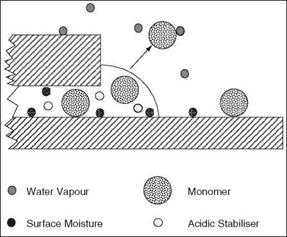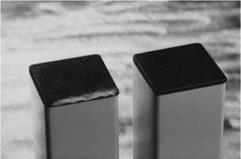Blooming occurs when cyanoacrylate molecules escape from the main body of the adhesive and react with water vapour in the surrounding air. The molecules of cyanoacrylate cure and then fall to the adjacent surface as a white powder (Figure 10.4). Even with rubber-toughened cyanoacrylates (which are often black in colour), it is the monomer which escapes and the deposit will still be white.
An example of blooming is shown in Figure 10.5 where excess adhesive was applied to the end cover of a shelf support unit.
There are three primary causes of blooming [3]:
1. Excess adhesive,
2. Slow cure, and
3. Low relative humidity.
|
Figure 10.4 When a cyanoacrylate ‘blooms’, the adhesive monomer escapes from the bond line and cures on an adjacent surface |
|
Figure 10.5 On the left-hand plastic extrusion, the cyanoacrylate has bloomed |
 15 января, 2016
15 января, 2016  Pokraskin
Pokraskin 

 Опубликовано в рубрике
Опубликовано в рубрике 